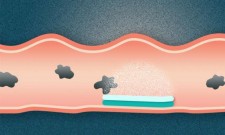 Long-term drug release via Phys.org
Long-term drug release via Phys.org
Extended release pills or capsules have three potential benefits over their standard counterparts: (1) sustained blood levels of the drug, (2) fewer side effects, and (3) improved compliance. Sometimes these formulations offer only limited therapeutic advantage and are developed for extension of patents or other financial reasons, but in many cases the advantages are substantial.
The description of novel type of pill design, which was developed by researchers at Massachusetts Institute of Technology and Brigham and Women’s Hospital, was recently published in the journal Advanced Healthcare Materials. The new technology enables an orally-ingested pill to actually adhere to the mucus membrane lining of the gastrointestinal tract (GIT) enabling the slow release of medication. One side of the pill faces the lumen of the GIT, which enables it to repel food and liquids by allowing it to withstand mechanical shearing forces.
“This could be adapted to many drugs. Any drug that is dosed frequently could be amenable to this kind system,” according to one of the senior authors of the paper, Giovanni Traverso, a research affiliate at MIT’s Koch Institute for Integrative Research, and a gastroenterologist at Brigham and Women’s Hospital.
Drug delivery systems that are capable of attaching to the lining of the GIT are referred to as “mucoadhesives,” which have the advantages of increasing plasma concentrations of the drug, and also providing better therapeutic activity. The concept has been around since the early 1980’s and has gained considerable interest in pharmacological technology. Mucoadhesive drug delivery formulations have also been developed for oral, buccal (inside the cheek), nasal, rectal and vaginal routes for systemic and local effects.
Mucoadhesive drugs provide the following advantages over other forms of controlled release by “virtue of prolongation of residence time of drug in gastrointestinal tract.”
- Targeting and localization of the drug at a specific site
- Intimate contact between the drug and absorptive mucosal lining of GIT – enables increased drug delivery
Scientists used tissue from the intestinal lining from pigs to test three different versions of their tablet: a mucoadhesive tablet, a dual-sided omniphobic tablet (repels everything it encounters), and what they call a “Janus” (two-faced Roman god) device that has one mucoadhesive and one omniphobic side. Only the Janus prototype was able to stay attached to the epithelial lining of the GIT and withstand the tumultuous environment.
“There are certain medications that are known to get stuck, particularly in the esophagus. It causes this massive amount of inflammation because it gets stuck and it causes irritation,” states Dr. Traverso. “Texturing the surfaces really opens up a new way of thinking about controlling and tuning how these drug formulations travel.”
Not only would multiple-day dosing be eliminated but this technology could allow for multi-drug delivery, which would greatly simplify drug regimens. Additionally, this delivery system would be able to bypass the liver, where most drugs are metabolized prior to their systemic distribution hence reducing the amount of medication delivered (bioavailability) – which means less of the drug needs to be used. Because the epithelial lining of the GIT is superabsorptive, less time is needed to effect a response to a medication. It goes without saying that this research has tremendous clinical applications.



